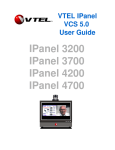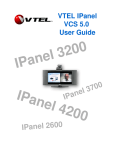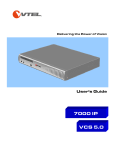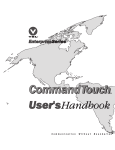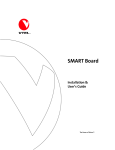Download VTEL IPanel 4200 User guide
Transcript
VTEL IPanel
VCS 6.0
User Guide
IPanel 4200
IPanel 4700
IPanel 5500
IPanel Systems
Videoco nferencing
with
Data Sh aring
All-In-One Professional Solution
VTEL IPanel 3200/4200
26/32”
Internet
&
PC Application s
Initial Setup
IPanel 4200/4700/5500
Internet/LAN
AC
“Easy to Drive”
One click operation
Mult imed ia
Presentations
Optional
Cable
HDTV
Please verify the following items are included with your shipment; camera with
mounting bracket, camera power supply, wireless keyboard, PC power supply,
DVD player power supply, panel IR remote, and software (including Windows XP
Pro).
1. Camera mounting
B. Using a Philips screwdriver remove
the large silver screw from the bottom of
the camera and use it to mount the
camera mounting plate to the camera. Be
careful not to over tighten the screw.
Note: The L-shaped part of the mounting
plate (containing two small holes) should
face toward the back of the camera.
A. Remove camera and
camera mounting plate from the
camera box (located in the
accessories box).
+
C. Use two screws to mount camera
bracket and camera to the mounting plate
holding the PC. Be careful not to over
tighten the screws.
Align the camera bracket with the front
of the monitor and stick it down with the
double sided tape.
+
D. Connect the two cables (top of the LCD monitor) to
the camera --Yellow to composite, black to RS-232.
Make sure the camera power supply is connected to
camera and AC outlet.
All camera cables must be connected before
powering on the computer.
2. Power and network
A. Connect an RJ45 cable from your Internet or
LAN (local area network) connection to the
bottom of the computer in either RJ45 port.
B. Connect the power supply
adapter-- a transformer (“brick”)
receptacle located on the bottom
left side of the computer. The
power supply adapter is found in
the accessory box.
C. Check all cables to ensure none came loose
during shipping.
2. Power and network
(continued)
D. On the back of the panel ensure the power cable is connected
E. Configure your External IP network using the Network Configuration Guide in Section 6.
F. The hardware set up is complete. You should not have to do this again unless the system is
moved to a new location.
3. Starting up the system
A. Power on the system using the power
button on the top of the computer and the
power button on the left side of the monitor
B. The system will start up like any other Windows
XP computer going through familiar screens.
C. This computer screen should be on the left side of
the monitor. If it isn’t go now to 3A “Arranging Proper
Displays” . Your monitor needs to be configured for
NORMAL Videoconferencing mode.
D. Double click on the red “V ball”
(“Start VTEL VCS” shortcut)
in the upper left corner. This launches the
videoconferencing software.
E. After a brief loading process, a large
VTEL “V ball” appears on the lower right
of the screen. This says that the videoconferencing software is loaded.
Note: if you do not see the
usual Windows XP screen on
the left side during start up go
to section 3A to configure
monitor and then return to this
section.
3A. Startup -- Arranging Proper Displays
When you turn on the flat panel and the PC you may find a display other than
The NORMAL videoconferencing mode of PC on the left (HDMI 1) and Videoconferencing (VGA) on the
right.
The flat panel will start up in the same mode that it was when it was turned off.
So, if someone was watching TV and then turned off the system, the panel will
return (start up) in TV mode.
The following steps will get you to the NORMAL videoconferencing mode regardless
of the configuration of the panel during startup.
Steps:
A. Toggle the
button until you see two equal side-by-side displays
The goal is to get HDMI on the left and RGB on the right.
B. Press the
C. Press
button until HDMI appears on the left.
until RGB appears on the right.
Now you are in NORMAL Videoconferencing mode.
Return to step 3.
Function
Source
Computer PC
HDMI-1
Videoconferencing
video
RGB
Television
Cable
4. NORMAL Videoconferencing
A. The split screen at right will appear.
The left half is your local PC.
The right half is the videoconferencing section.
Place a Call
Audio Mute
Video Mute
Volume Control
Local Video
My IP Address
Exit VTEL Now
Cancel
Note: The keyboard mouse works normally as a
PC mouse when the cursor is in the PC area…
and the keyboard mouse works as a videoconferencing
controller when the cursor is in the videoconferencing
area.
B. Move the cursor to the right hand section (it will turn blue)
C. Right-click and the videoconferencing menu appears:
4A. Videoconferencing Menu – Placing a call
Managing the address book
1. Call Rate
2. IP Address
192 or 256 is a good
rate for the Internet
Enter the IP address
you are calling
Use tabs to toggle
between hand dialer
and address book
3. Click “Dial”
Address Book
Speed Dial Keys
Hand Dialer
Hand Dialer – for ad-hoc connections
• Use this 3-step process when you just want to
connect to another site not in the address book.
• Call yourself in loop back by dialing your own IP
address to test that your system is working OK.
Address Book– for routine connections
• From list -- Use your cursor to highlight in blue
the site and then “left double click”.
• Speed Dial – Place the cursor over the speed dial
key and “left click”
• Put any site on a Speed Dial key by highlighting
the horizontal entry and drag and dropping it onto a
key.
• To add a site -- Right click in the “address book”
(white) portion and bring up menu with “add” at the
top. This is how to add sites to your address book.
4B. Videoconferencing Menu
Place a Call
Audio Mute
Video Mute
Volume Control
Local Video
My IP Address
Exit VTEL Now
Cancel
An ICON appears on
your VC screen showing
status of audio and video mute
Muting -- On Master Menu click:
• Audio Mute so far site cannot hear you
• Video Mute so far site cannot see you
• Undo mute – click on the mute line on
Master Menu again or,
• Click on the ICON displayed on your VC
screen.
Volume: put your cursor where you
want the volume to go and left click.
Slide bar appears on PC side of screen
4C. Camera controls using the keyboard mouse
Using the mouse to control cameras is very natural … just
point where you want the camera to go.
Remote Camera
pan
Cursor is small and white when
moved into left (PC) zone
left/right/up/down
IPanel System s
V ideoconferencing
with
Data Sharing
All-In-One Professional Solution
VTEL IPanel 3200/4200
26/32”
Internet
&
PC A pplications
Internet/LAN
AC
“Easy to Drive”
One click operation
M ultim edia
Presentations
Optional
Cable
HDT V
Cursor is big and blue when
moved into right (VC) zone
Cursor is big and yellow when
moved into PIP window (PIP) zone
When in PIP zone the cursor controls
your local camera in the same way the
blue cursor controls the far camera
Left-click (and hold) to
move cameras
+
-
Zoom Zoom
In
Out
4D. Videoconferencing Menu – Local IP address
Hang Up
Address Book
Audio Mute
Video Mute
Volume Control
Send PC
Local Video
My IP Address
Cancel
Left-click on “My IP Address”. This is the number that
other people should call to reach this system. It’s like a
phone number.
The IP address appears on the top of the PC (left)
screen in PC/VC mode. If you are in VC mode (far site
video picture only) the IP address will not appear.
Note: VCS 6.0 only detects the user’s IP address when it
launches. If you change your IP while VCS 6.0 is running
it will not know about it and your calls won’t work. To
remedy this problem, just Exit VCS (by selecting Exit
VTEL Now), and then launch VCS 6.0 again.
4E. Videoconferencing Menu – Local Video
Local Video shows what your local camera is seeing. It normally goes into a PIP
(Picture In Picture) window in the videoconferencing section (right side).
Hang Up
Address Book
Audio Mute
Video Mute
Volume Control
Send PC
Local Video
My IP Address
Cancel
Shows your video in PIP window
Removes local video (PIP)
Show Local Video
Hide Local Video
Dock/Undock PIP
• Undock: makes local video into
PC-style window. You can
resize and move anywhere
move
• Dock: removes top blue bar and
“docks” PIP window where you
last put it
Your local
picture
(undocked)
size
4F. Videoconferencing Menu – Send PC
During a videoconference you can present PowerPoint slides (or any other PC application)
to the other participants.
For PowerPoint:
IP anel S ystems
Hang Up
Address Book
Audio Mute
Video Mute
Volume Control
Send PC
Local Video
My IP Address
Cancel
• While in PC/VC mode (like picture at right), start
your PowerPoint application in the left (PC) side.
Maximize the size of the slides locally.
V id eoconf erencing
wit h
Da ta S haring
A ll-I n-O ne P rof essional S olution
V TE L I Panel 3200/4200
26/32”
I nte rnet
&
P C A ppl icati ons
In te r ne t /L AN
AC
“E asy to Dri ve ”
On e cl ick o p era tio n
M ult im edi a
P rese ntat ion s
Op tion al
Cab le
HDT V
• Right-click on the video (right) side and bring up
the videoconferencing menu
• Select “Send PC” – an ICON appears on your
video side.
• In about 10-15 seconds the far site conferencing
unit will also see your PowerPoint slide … exactly
the same as you see it (same size and quality)
IP anel S ystems
V id eoconf erencing
wit h
Da ta S haring
A ll-I n-O ne P rof essional S olution
V TE L I Panel 3200/4200
26/32”
• Click on your PowerPoint slide and it will
automatically (like normal) advance to the next
slide. In about 5-10 seconds the remote site will
see the new slide.
I nte rnet
&
P C A ppl icati ons
In te r ne t /L AN
AC
“E asy to Dri ve ”
On e cl ick o p era tio n
M ult im edi a
P rese ntat ion s
Op tion al
Cab le
HDT V
• When finished sharing slides select “Stop
Sending PC” from the main white menu.
Note: The time it takes to transfer a slide is
dependent upon the bandwidth of the connection
between IPanel systems.
Note: If you are sending PC slides to the far site
and they start “Send PC” at their end, it will cancel
your Send PC and you will start receiving their PC
data.
Tip: Bring your flash drives to the meeting (videoconference or
local). Load your PC files into the IPanel. There is a convenient
USB port on the upper right-hand side of the IPanel computer.
System modes -- videoconferencing
The IPanel has three main videoconferencing modes of operation.
You can toggle from one mode to another using the keyboard function
keys on the wireless keyboard
IP an e l S y stem s
IPanel Systems
Vide oco nf er enc ing
wit h
Da ta Sha rin g
A ll-In-One P rofes sional S olution
V TEL IPanel 3200/4200
V i d e o c o n fe re n c i n g
w i th
D a ta S h a ri n g
A l l- I n - O n e P r o f e s s io n a l S o lu t io n
V T E L I P a n e l 3 2 0 0 /4 2 0 0
26/32”
In te rn et
&
PC Ap plica tio ns
2 6/3 2”
In te rn e t
&
P C A p p l i c a t io n s
Inte rnet/L AN
AC
“Easy t o D riv e”
One cl ick operati on
M ult ime dia
Pr es en tat ion s
Optional
Cable
I n t e rn e t / L A N
AC
HDTV
“ E a s y to D r iv e ”
O n e c lic k o p e r a t io n
M u l t im e d i a
P r e s e n ta ti o n s
O p ti o n a l
C a b le
H DT V
PC and VideoConferencing side
by side - NORMAL
Normal operation
for videoconferencePC information on
left, video on right
Full Screen PC
See full screen of received
PC data in videoconference.
or see full size presentation
locally when not in a
videoconference
Videoconferencing
See full screen of far
site in videoconference
Take PC full screen
IP a n e l S ys te m s
IP a n e l S ys te m s
IPanel Systems
IPanel Systems
V ideoconf erenc ing
wit h
Dat a S hari ng
A ll-In-On e Prof ession al So lu tion
V TEL I Pan el 32 00 /42 00
V id e o c o n f er e n c in g
w it h
D a t a S h a rin g
A ll -I n - O n e P ro f e s s io n a l S o lu ti o n
V T E L I P a n e l 3 2 0 0 /4 2 0 0
26/32”
I nt ernet
&
P C A pplic at ions
V id e o c o n f er e n c in g
w it h
D a t a S h a rin g
A ll -I n - O n e P ro f e s s io n a l S o lu ti o n
V T E L I P a n e l 3 2 0 0 /4 2 0 0
I nt e r n et
&
P C A p p lic a t io n s
AC
“E a s y to D r i v e ”
O n e c l ic k o p e r a t io n
M u l t im e di a
P r es e nt a t io n s
M u l t im e di a
P r es e nt a t io n s
O p tio n a l
C a b le
H DT V
H DT V
Left screen can go full screen
Press VIEW once
(to make computer full screen)
Mult imedia
P res entat ions
Optional
Ca ble
HDT V
AC
“E a s y to D r i v e ”
O n e c l ic k o p e r a t io n
O p tio n a l
C a b le
V ideoconf erenc ing
wit h
Dat a S hari ng
I nte rn e t/L AN
AC
“Ea sy to Drive ”
O ne cli ck o peratio n
I n te r n e t/ L A N
I n te r n e t/ L A N
HDT V
26/32”
I nt ernet
&
P C A pplic at ions
I nt e r n et
&
P C A p p lic a t io n s
Mult imedia
P res entat ions
Optional
Ca ble
A ll-In-One Prof essional Solution
V TEL I Panel 3200/4200
26/32”
26/32”
I nte rn e t/L AN
AC
“Ea sy to Drive ”
O ne cli ck o peratio n
Press VIEW again Press VIEW again
(to get video in
PIP window)
(to return
normal ops)
Take Video full screen
IPanel Systems
IPanel Systems
IPanel Systems
V ideoconf erenc ing
wit h
Dat a S hari ng
A ll-In-One Prof essional Solution
V TEL I Panel 3200/4200
26/32”
“Ea sy to Drive ”
O ne cli ck o peratio n
IPanel Sy stems
V id e o co n f e re n c in g
w it h
Da t a S h a ri ng
26/32”
AC
Videoconferencing
w ith
D ata Sharing
26 /32 ”
Inte rnet
&
PC Applicatio ns
HDT V
In t e r ne t
&
P C A pp l ica t io n s
M u lt im e d ia
P re s e n ta t io n s
“Ea sy to Drive ”
O ne cli ck o peratio n
Int er ne t/ LAN
AC
O ptional
Ca ble
H DT V
“Ea sy to Drive ”
O ne cl ick opera ti on
M u lti m e d ia
P re s e n ta t io n s
O ptiona l
C able
HD T V
I n t ern e t / L A N
AC
“E asy to Drive”
One cli ck oper ation
26/32”
I nte rn e t/L AN
IPanel Syst ems
A ll-I n-One P rofessional Sol ution
V TE L I Panel 3200/ 4200
Mult imedia
P res entat ions
Optional
Ca ble
Vi d eo c o n fe r e n c in g
w it h
D a t a S h ar in g
A ll-In-One P rofessional S olution
VTEL IPanel 3200/4200
I nt e r n e t
&
P C A p p lic at io n s
I nt ernet
&
P C A pplic at ions
I nternet/LAN
AC
HDT V
A ll-In-One Prof essional Solution
V TEL I Panel 3200/4200
26/32”
Mult imedia
P res entat ions
Optional
Ca ble
V ideoconf erenc ing
wit h
Dat a S hari ng
A ll-In-One Prof essional Solution
V TEL I Panel 3200/4200
I nt ernet
&
P C A pplic at ions
I nternet/LAN
AC
“Ea sy to Drive ”
O ne cli ck o peratio n
Multimedia
Pr esentatio ns
Op t io na l
Ca bl e
HD TV
Left screen can go full screen Press VIEW Press VIEW Press VIEW Press SWAP
(to make video
(to get PC in
(to return to
(to return to
Press SWAP once
(to put video on the left
full screen)
PIP window)
split screen)
normal ops)
IPanel Systems
Videoconferencing
with
Data Sharing
All-In-One Professional Solution
VTEL IPanel 3200/4200
26/32”
Internet
&
PC Applications
Internet/LAN
AC
Multimedia
Presentations
“Easy to Drive”
One click operation
Op ti onal
Cab le
HDTV
Note: This side-by-side display is the NORMAL
Videoconferencing mode because it aligns the
cursor control correctly. This means when you
move your cursor to the right it goes smoothly
from the left (PC) screen to the right. If these images
are reversed you would have to move your cursor to
left to go from the PC screen to the Video screen.
Function
Source
Computer PC
HDMI-1
Videoconferencing
video
RGA
Television
Cable
System mode -- Television
IP a n e l S ys te m s
IPanel Sy stems
IPanel Sy stems
2 6 /3 2 ”
“Ea sy to Drive ”
O ne cl ick opera ti on
26/32”
In t e r ne t
&
P C A pp l ica t io n s
I nt e r n et
&
P C A p p lic a t io n s
M u lti m e d ia
P re s e n ta t io n s
O ptiona l
C able
M u lti m e d ia
P re s e n ta t io n s
O ptiona l
C able
HD T V
AC
“E a s y to D r i v e ”
O n e c l ic k o p e r a t io n
Int er ne t/ LAN
AC
“Ea sy to Drive ”
O ne cl ick opera ti on
I n te r n e t/ L A N
HD T V
Vi d eo c o n fe r e n c in g
w it h
D a t a S h ar in g
A ll-In-One P rofessional S olution
VTEL IPanel 3200/4200
26/32”
In t e r ne t
&
P C A pp l ica t io n s
Int er ne t/ LAN
AC
V id e o c o n f er e n c in g
w it h
D a t a S h a rin g
A ll -I n - O n e P ro f e s s io n a l S o lu ti o n
V T E L I P a n e l 3 2 0 0 /4 2 0 0
Vi d eo c o n fe r e n c in g
w it h
D a t a S h ar in g
A ll-In-On e P ro fession al S olutio n
VTEL IPan el 3 20 0/4 200
M u l t im e di a
P r es e nt a t io n s
O p t io n a l
C a b le
H DT V
Left screen can go
full screen
Press LEFT INPUT
until
Cable appears
Press VIEW until
TV is full screen
Press LEFT
INPUT until
HDMI 1 appears
(to get back to PC)
Press VIEW until
back in normal
mode
6. IPanel Network Setup for Public Internet
• The IPanel is designed to videoconference over the public Internet. The initial setup may involve
your local IT (computer network) support person to configure your IP network parameters-especially your network firewall and some internal IPanel settings.
• This will only have to be done once at initial system installation. Thereafter, the user will
simply call other videoconferencing systems using the IPanel address book.
• This decision tree flow chart covers all of the common network configuration conditions. Go to the
next page for the detailed step-by-step actions required (items A, B, and C)
Is there a
Firewall?
NO
A
YES
Does network
use DHCP?
NO
YES
Does network
use DHCP?
YES
IPanel Settings
NO
IPanel Settings
• IP Address
• Subnet Mask
A
• IP Address
B
B
• Subnet Mask
• Default Gateway
• Default Gateway
• Preferred DNS Server
• Preferred DNS Server
• Alternate DNS Server
• Alternate DNS Server
Modem internal addresses
Source: ISP
Firewall internal addresses
Source: Network admin
Configure Firewall for Videoconferencing
• Open 1720 TCP port (incoming)
• Open 1718, 1719 UDP ports (incoming)
• Open 5004-6004 TCP and UDP ports
(outgoing/incoming)
• Forward traffic to IPanel
Does firewall do NAT?
NO
YES
OK
Enable NAT
on IPanel
C
6. IPanel Network Setup for Public Internet
A
B
C
By default, your IPanel is setup to use automatic IP detection (DHCP)
on both of its Ethernet ports. If your internal network is configured to
use DHCP (which is the most common case) then simply plug in a
network cable into either port on the IPanel.
• Once you have this information, open up the network properties page
on the IPanel by going to START->CONTROL PANEL->NETWORK
CONNECTIONS on Windows XP
• RIGHT CLICK on "Local Area Connection" or "Local Area Connection
2" and select PROPERTIES (see note below) One connection will
say connected, one will say network cable unplugged. Use the
connected network choice.
• In the properties page LEFT CLICK on "Internet Protocol (TCP/IP)" to
highlight it and then press the PROPERTIES button.
• Toggle both selections from "Obtain...Automatically" to "USE THE
FOLLOWING…” and then enter the five pieces of information you
gathered earlier into the appropriate boxes. Once you've entered this
information press OK to close the dialog.
• Verify network connectivity by selecting Internet Explorer on the
IPanel and connecting to a public web site (it is the same process as
any other computer).
• Note: there are 2 Ethernet adapters on the back of the IPanel. You
can use either one, but if you are setting up a static IP address on your
IPanel make sure you setup the same network properties for the same
port you plug your cable into. (Facing the back of the iPanel adapter 1
is on the left ("Local Area Connection") and adapter 2 ("Local Area
Connection 2") is on the right. It's perfectly ok to set-up both adapters
with the same information.)
Load VTEL's System Configuration. Under the Network tab, check the
"Enable NAT" box and enter your public/external IP address in the box (you
may have to ask your ISP/Network Administrator for this address). Press
"OK" to close System Configuration and apply the settings.
Cable Assembly
1)
2)
3)
4)
5)
6)
Attach Power supply to PC
Attach HDMI-HDMI cable from PC to HDTV.
Attach keyboard dongle (RF receiver) into any USB port on PC
Attach BOSE speakers to PC (plug in speaker power supply)
Attach LAN connector to PC
The keyboard and the dongle receiver are synchronized at the factory.
If you need to resynchronize the keyboard, use the following process.
6A) Setting ID: press ID button on dongle receiver, the green
LED will flash which means the ID is searching
6B) Press the ID button on the keyboard. The green LED on the
dongle receiver will turn off. This means the
connection between the keyboard and the
dongle receiver is successful.
7) Attach CD/DVD player to PC using the two USB connections
8) Attach cable/antenna coax cable to HDTV
CD/DVD
6B. Push ID button -the keyboard will
connect to dongle receiver
6A. Push ID button -the green LED will flash
7. Attach using two
USB connectors
3. Keyboard
dongle
4. Speaker
cable
2. HDMI cable
5. LAN
1. PC power supply
8. Cable TV
Cable Assembly (continued)
8.
8. Mount the camera to the LCD monitor using the
camera mounting bracket.
9. Connect the S-Video cable to the camera and to the PC
10. Connect the VGA control cable (camera motion) to the camera
and to the PC
11. Connect the external power supply
12. Connect wireless charger/receiver to blue audio input
13. Connect IR transmitter to front (lower left side) of HDTV panel
using the VELCRO strips. Note: the VELCRO strip is
already on HDTV lower left front.
14. Connect the wired microphone(s) to pink input (if not using
wireless microphones).
11. Camera power
9. S-Video cable
10. Camera control cable
13. IR Transmitter
This controls HDTV
Mode switching
(any USB port)
12. Wireless microphone
charger/receiver (shown
charging microphone)
Connect into blue PC input
14. Wired microphone to
pink PC input
The IPanel uses either all
wireless OR all wired
microphones…not a
combination of the two.














